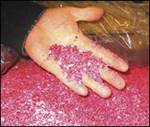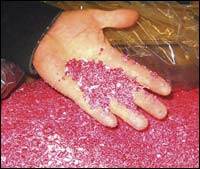Processors: Gear Up to Handle More Regrind
Plastics auxiliary and primary processing equipment was optimized for running pellets; here’s how you can adjust to the bulk density differences of flake and regrind in drying, conveying, mixing, feeding and processing.
Plastics processing has traditionally used pellets as the ideal material input, and a wide range of processing and auxiliary equipment has been optimized around the idea that plastic materials and additives are moved, blended and processed primarily in pelletized form. Some commercial material recyclers collect, clean and reprocess plastic materials into pelletized forms for sale back to processors. Others collect and clean the materials, but then sell flake to processors willing to run regrind, which has a lower cost than pelletized postconsumer recycled (PCR) resin.
At the same time, processors have — in the name of efficiency — opted to reuse in-house scrap by size-reducing it and then reintroducing it into their processes. However, as consumer and regulatory pressures for higher recycled content continue to build, recyclers are seeking ways to expand capacity, while processors are exploring how to use higher ratios of regrind in their processes. To succeed, both recyclers and processors face several real challenges.

Another solution for lightweight hard-to-flow regrind materials is a hopper equipped with a side-feed auger that dispenses materials directly to the blender’s mixing chamber. Source (all images): Conair
In addition to the challenge of ensuring the consistency and quality of regrind materials, other difficulties involve practical problems in terms of efficiently capturing, managing and utilizing higher regrind volumes through systems. The question becomes: How do you size reduce, convey, crystallize (if necessary), dry, feed and blend the regrind and get it to the machine throat — whether that’s an injection molding machine or extruder?
As a major supplier of auxiliary equipment and integrated systems, Conair has felt the impact of this increased demand, both in terms of recycler and processor questions, and in the rising demand for larger capacity and higher throughput equipment and systems. Even as we and other suppliers build and deliver this equipment, we found that no one approach can meet every equipment need or recycling challenge, so that a wide variety of practical, profitable solutions must be available.
Collecting and Consolidating Recyclable Materials
Some processors who aren’t equipped with size reduction equipment like shredders or granulators, simply sell their scrap — sprues, runners, faulty parts — to a recycler/pelletizer. Other processors have been reclaiming in-house scrap or acquiring and using PCR for years.
If you’re a PET film or thermoform producer, or a maker of HDPE/LDPE bottles or containers, it’s relatively easy to collect a lot of scrap. But consider how that material gets to the shredder/granulator, and how it arrives to the point of reuse. If you’re collecting bottle tabs/tails, film or thermoform scrap in bins, rolls or bundles, and then carting these around the plant with a forklift, there could be a better, less expensive and more efficient way.

Forklifting bins, bundles or rolls of scrap to a central location for batch size-reduction costs labor time and space. Press-side size-reduction and automated evacuation through a central conveying system may simplify the process.
Often, size reduction equipment can be sized for the application, whether that’s injection molding or continuous extrusion, and is then augmented by an expanded conveying system to handle evacuation of regrind to a central location. Such press-side or in-line size reduction approaches — together with automated conveying — can simplify recycling and cut the amount of equipment needed, thereby reducing floor congestion thanks to a smaller footprint, while minimizing labor costs and boosting employee safety. All material is collected in granular or flake form at a central point, whether via a crystallizer or a surge bin, for reprocessing.
Delivering Regrind or Flake to Production Processes
While size reduction equipment is optimized to handle all sorts of scrap, most processing equipment is designed around pelletized materials. This means that while many processors may find it relatively easy to deliver and process a low ratio of regrind or flake in existing equipment, accommodating higher ratios will cause problems.
At the root of these problems are fundamental differences between regrind/flake and pellets. Regrind/flake is bulkier, greater in volume, lighter in weight and far more irregular in shape. It often doesn’t flow with the same predictability and smoothness of pellets.

A blending material hopper provides mechanical agitation to break up regrind and ensure free material flow.
The characteristics of regrind also differ based on the source of the scrap. Material from thicker wall molded or extruded parts is relatively dense, so after size reduction, the granules tend to be heavy enough to maintain some gravity flow, but other materials can be much tougher to handle. Sheet materials and films are not only more difficult to size reduce, but they also produce light, flat and flaky regrind that bunches up easily and resists flow. Consider the fact that extruded PET sheet or agricultural films may range in thickness from between 5 and 20 mils. Even more difficult is regrind from foamed products whose air-expanded structures are so feathery light that they resist even mechanical assistance.
Producing systems to handle greater ratios of flake requires some planning because flake has a tendency to flatten out, bunch up, bridge or otherwise refuse to move, leading to ratholing or clogs and causing material conveying problems, particularly at pickup and discharge points. It can also trigger problems in material drying, feeding and blending.
Mechanical Agitation and Flow Enhancement
A lack of flowability is the common denominator when handling regrind, especially flake. Fortunately, there’s also a common solution — flow-enhancing designs and devices — to keep material moving. These include:
- Conveying airlocks with mechanical feeds or modular distribution boxes with internal agitators, that keep material moving toward conveying takeoffs
- Bins that incorporate mechanical “clump breakers” or augers
- Blender bins with mechanical augers or special, funnel-shaped mixing bins designed with flow-inducing augers to keep flake or film moving consistently
- Filterless receivers that incorporate a “cyclone” design to separate lighter materials from the conveying airstream or loaders that include air knives to keep material moving

This tapered blender mixing bin features an agitator to ensure free material flow.
A range of tools also exist for feeding regrind or flake for reprocessing. Selection of these tools depends on the precision desired in the material mix. When the virgin/regrind mix ratio isn’t critical to product quality, a simple ratio valve may do the job, providing a steady stream of regrind or flake into the machine throat. When ratio accuracy is more critical, an auger-driven feed of light materials like film or flake, either to the blender or to the machine throat, is the right answer.
Managing Greater Volume and Lighter Weight
Flowability is one issue to address, but there’s a more practical problem. In the name of precision, virtually every capacity in plastics processing equipment is rated in terms of lbs/hr based on pelletized materials. Using higher ratios of regrind and flake throws a wrench into these ratings, because lighter bulk density material has the effect of changing equipment and system capacity.
To achieve an equivalent throughput of regrind/flake — whether in conveying, drying, blending or processing — you must move and handle a larger volume of lighter material. With low regrind ratios, this volumetric difference is easy to overlook, but as the ratio increases, the greater volume of regrind, relative to pellets, has the effect of reducing the capacity and throughput of your equipment. Consider a few examples:
Surge Bin. Let’s say that you want to up the percentage of regrind in a process that was sized for pelletized virgin material at 35 lbs/ft3 and fed from 10-ft3 surge bins each holding 350 pounds of material. If you switch one bin to regrind, which has a bulk density of 25 lbs/ft3, that surge bin now only holds 250 pounds of material. If that surge bin is being used for surge capacity and you don’t adapt your conveying/material fill rates, you could starve the downstream machine.
Blending. If you’re consuming a given amount of material per hour at a blend of 30% and you increase the blend to 50%, then you have to rethink your conveying cycles in order to properly feed the process. In addition, if you add loading time to your conveying system, the system must have the capacity to meet that need; otherwise, you could be starving your process of material.
Drying. If a processor sizes a system to dry 5,000 lbs/hr of pellets, but then shifts to handling regrind, throughput will be reduced due to the difference in bulk density. For example, shifting a drying process from PET pellets with a density of 52 lbs/ft3 to PET flakes at a density of 25 lbs/ft3 causes a major change in throughput. To produce an equal throughput of dried PET flake, the drying hopper must be increased to about twice its original size or you’ll need to run the system approximately twice as long — double the residence time in the hopper — to process the added material volume, but even then, you may not be home free. Sometimes, it is necessary to upsize drying equipment because the dryer may need more “oomph” to consistently drive airflow through tightly bunched layers of flake regrind, which can act as a barrier to airflow.
Conveying. The lower bulk density of regrind and flake means that if you increase the ratio of regrind, and all other things remain equal, you’re moving less material (for example, lbs/hr) through your systems. To maintain the throughput that you’re used to having, you will have to move material more often (such as add more receiver loading cycles/hr or less “reserve” time) and/or expand your storage space. In practice, this can be done in several ways:
- Running more frequent fill cycles to keep existing receivers topped off. This requires spare pump capacity.
- Expanding bin and receiver capacity by using modular bin extensions and “stretch” body receivers, in addition to longer fill cycles.
- Subdividing existing pump or conveying system capacity into smaller subsystems that each serve a lower number of receivers. This increases reserve time and enables the system to keep up in worst case scenarios, such as when all receivers call for material at the same time.
- Expanding conveying line size and pump capacity to handle higher volumes with similar loading times, where greater capacity enables the system to pull more material in the same amount of time.
In addition, the use of filterless receivers is also recommended, because dusty, flaky regrind can clog or blind mesh filters and result in maintenance headaches. Conair’s FilterLess receivers use a reversing cyclonic action to separate material from the conveying airstream.

Modular bolt-on extensions for drying hoppers, like this ‘top hat,’ provide an inexpensive way to expand hopper capacity when drying recycled materials with reduced bulk densities.
It’s not news that the challenges associated with handling postindustrial and PCR materials have existed for many years. What is new is regulatory and consumer pressures driving the industry and individual processors to confront the challenges of processing more regrind with growing urgency. The technology and knowledge needed to support higher and higher ratios of recycled/regrind materials in processing certainly exist, but the decisions to be made about employing technology must be considered carefully and systematically to ensure the most efficient and profitable results.
About the Author: Nick Paradiso was recently promoted to senior director, sales operations, at the Conair Group. In this role, he oversees the work of the systems team, which includes system application engineers, project estimators, the project management, project engineering and unit sales teams. Contact: 724-584-5557; nparadiso@conairgroup.com; conairgroup.com
Related Content
Processing Megatrends Drive New Product Developments at NPE2024
It’s all about sustainability and the circular economy, and it will be on display in Orlando across all the major processes. But there will be plenty to see in automation, AI and machine learning as well.
Read MoreMultilayer Solutions to Challenges in Blow Molding with PCR
For extrusion blow molders, challenges of price and availability of postconsumer recycled resins can be addressed with a variety of multilayer technologies, which also offer solutions to issues with color, processability, mechanical properties and chemical migration in PCR materials.
Read MoreFoam-Core Multilayer Blow Molding: How It’s Done
Learn here how to take advantage of new lightweighting and recycle utilization opportunities in consumer packaging, thanks to a collaboration of leaders in microcellular foaming and multilayer head design.
Read MoreNPE2024 Wrap-Up: Sustainability Dominates Show Floor News
Across all process types, sustainability was a big theme at NPE2024. But there was plenty to see in automation and artificial intelligence as well.
Read MoreRead Next
How Much Regrind Can You Handle?
Most extrusion operations generate scrap, and in the case of sheet for thermoforming it can exceed 70% of total output.
Read MoreSmart Handling of Regrind Can Improve Your Bottom Line
Dealing effectively with regrind has been a tough challenge for most blow molders ever since the process was invented.
Read MoreBulk, Solid and Melt Density: How to Calculate These Values and Why They Matter — Part 1 of 2
How much resin is contained within a bucket, gaylord or hopper? That depends on the bulk density — a figure you need to learn how to calculate due to its impact on everything from storage and conveying to drying and molding.
Read More





















